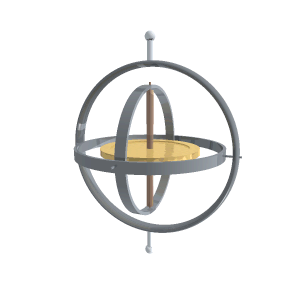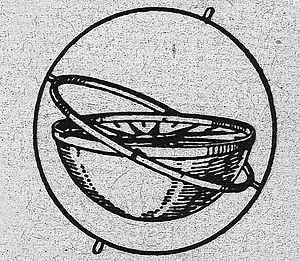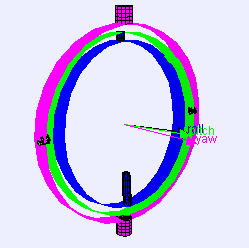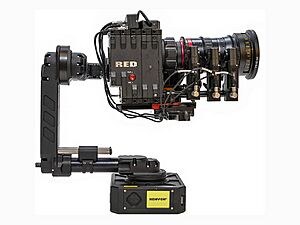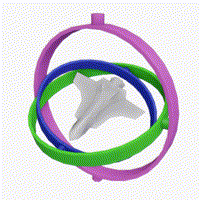Gimbal facts for kids
A gimbal is a special support that lets an object spin or tilt around an axis. Imagine a set of three gimbals, one inside the other, each letting something turn in a different direction. This setup helps an object stay steady, no matter how its support moves.
For example, on a ship, gimbals are used for things like gyroscopes, compasses, and even stoves. They keep these items upright and level, even when the ship is rocking and rolling on the waves.
This type of support is sometimes called a Cardan suspension. It's named after an Italian mathematician and physicist named Gerolamo Cardano (1501–1576). He wrote about it in detail, but he didn't actually invent it. People have known about gimbals for a very long time, since ancient times! The first known description was by Philo of Byzantium in the 3rd century BC.
Contents
How Gimbals Were Used Long Ago

The first person to describe a gimbal was a Greek inventor named Philo of Byzantium (who lived from 280 to 220 BC). He described an eight-sided ink pot. This pot had an opening on each side. No matter which way the pot was turned, you could dip a pen in it, and the ink would never spill out! This was possible because the inkwell inside was hung in the center using a series of metal rings, keeping it still.
In Ancient China, during the Han dynasty (202 BC – 220 AD), an inventor named Ding Huan made an incense burner that used gimbals around 180 AD. There are also hints that gimbals were used in China even earlier, in the 2nd century BC. Later, during the Liang dynasty (502–557), gimbals were mentioned for use in door and window hinges. An artisan even gave Empress Wu Zetian (who ruled from 690–705) a portable warming stove that used gimbals. Some old Chinese gimbal incense burners from the early Tang dynasty (618–907) still exist today.
The ancient Roman writer Athenaeus Mechanicus also described a gimbal-like device. He wrote about it during the time of Augustus (30 BC–14 AD). He called it a "little ape" (pithêkion). Military engineers used it to keep large siege machines steady on ships when attacking towns from the sea. Athenaeus said that this "little ape" should be fixed to the platform in the middle to keep the machine upright, no matter how the ship moved.
After ancient times, gimbals were still well-known in the Near East. In Europe, a recipe book from the 9th century called the Little Key of Painting mentioned the device. The French inventor Villard de Honnecourt also drew gimbals in his sketchbook. In more recent history, dry compasses were often hung in gimbals to keep them stable.
How Gimbals Are Used Today
Gimbals are super useful in many modern technologies. They help keep things steady or allow them to move smoothly in different directions.
In systems that help ships and submarines navigate, like inertial navigation systems, at least three gimbals are needed. They help a special platform stay fixed in space, even when the ship or submarine is turning or tilting. This is important for keeping track of where the vehicle is going.
Helping Rocket Engines Move
When it comes to rocket engines, gimbals are often used to help the engine move. This allows a single engine to steer the rocket by changing the direction of its thrust. Sometimes, two engines work together with gimbals to control the rocket's roll.
For Cameras and Photography
Gimbals are also used to mount all sorts of cameras, from small ones to huge photographic telescopes.
For photographers, especially those taking pictures of wildlife, single-axis gimbal heads are very helpful. They let a camera and a heavy telephoto lens balance perfectly. This makes it easy to move the camera smoothly while following subjects that are moving.
Very large gimbal mounts are used for tracking satellites. These mounts can move in two or three directions to follow objects in the sky.
Gimbals that are stabilized by gyroscopes are also used for cameras on planes. These cameras help with things like checking power lines, creating maps, and for surveillance. They can hold different types of cameras, like thermal cameras, and even laser rangefinders.
In Movies and Videos
Handheld gimbals with three axes are used in camera stabilization systems for making movies and videos. They let a camera operator hold the camera without it shaking or vibrating. There are two main types: mechanical and motorized.
Mechanical gimbals use weights to balance the camera. The camera sits on top, and a monitor and batteries are at the bottom to make it heavier. This balances the whole setup, allowing the operator to control the camera with very light touches.
Motorized gimbals use three special motors. These motors keep the camera perfectly level on all sides as the operator moves it. A sensor inside the gimbal detects movement and tells the motors how to stabilize the camera. This makes the camera look like it's floating smoothly through the air. Gimbals can also be attached to cars or drones to get steady shots, even when there's a lot of movement.
For Clocks on Ships
Old mechanical clocks used on ships were very sensitive to how they were positioned. To make sure they kept accurate time, these clocks were usually mounted on gimbals. This protected them from the rocking and rolling of the ship at sea.
What is Gimbal Lock?
Gimbal lock happens when a system with three gimbals loses one of its ways to move freely. This occurs when two of the three gimbal axes line up in the same direction. When this happens, the system can't move in every direction it normally could.
Even though it's called "gimbal lock," none of the gimbals are actually stuck. They can all still spin on their own axes. However, because two axes are now parallel, there's no gimbal left to handle movement around one specific direction.
See also
- Canfield joint
- Heligimbal
- Universal joint
- Cardan shaft
- Keyhole problem
- Trunnion


